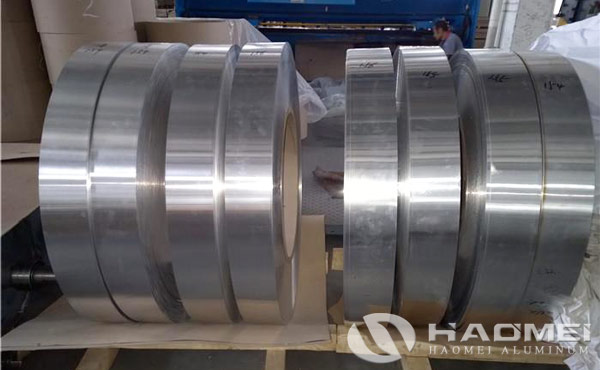1050/1060/1070 O Aluminium Strips For Transformer Winding
November 11, 2025
1050/1060/1070 O aluminium strip for transformer windings refers to aluminum strip made of 1050, 1060, and 1070 aluminum alloys in the O temper (soft temper) used for manufacturing transformer windings. These aluminum strips are commonly used in transformer windings because they possess good conductivity, corrosion resistance, and mechanical properties, effectively improving transformer efficiency and service life.

Specifically:
1050 Aluminum Strip:
1050 aluminum alloy has an aluminum content of not less than 99.5%, exhibiting excellent conductivity and corrosion resistance, suitable for applications requiring high conductivity and good machinability.
1060 Aluminum Strip:
1060 aluminum alloy has an aluminum content of 99.6% or higher. Its conductivity and corrosion resistance are similar to 1050, but 1060 aluminum alloy has slightly higher strength, suitable for transformer applications with higher requirements.
1070 Aluminum Strip:
1070 aluminum alloy has an aluminum content of not less than 99.7%, exhibiting even higher conductivity, suitable for transformer windings requiring higher performance.
Specifications of 1050/1060/1070 O aluminum strip for transformer windingsL
Thickness: Typically between 0.2-6mm; customization is available from different manufacturers to meet customer needs.
Width: Generally 20-1650mm, selectable based on transformer winding design requirements.
Applications: Mainly used in high and low voltage windings of dry-type transformers; also applicable to large transformers, solar energy, and power industries.
Appearance quality requirements: The surface should be smooth, free from scratches, burrs, and curled edges. Chamfering can be applied to the edges to prevent damage to the insulation material during winding, ensuring the transformer’s insulation performance.
Packaging method: Generally packaged on wooden pallets or fumigation-free wooden pallets with an inner diameter of 300mm or 500mm, using moisture-proof paper packaging with an inner paper sleeve to prevent damage and moisture absorption of the aluminum strip during transportation and storage.
Selection criteria of aluminum strip for transformer winding:
– Conductivity preferred
1060 O aluminum strip: Highest aluminum content (99.6%+), conductivity close to copper, suitable for resistance-sensitive transformer windings, reducing energy loss.
1070 O aluminum strip: Higher aluminum content (99.7%+), slightly better conductivity than 1060, but slightly more expensive; suitable for high-end transformers or applications with stringent efficiency requirements.
1050 O aluminum strip: Slightly lower conductivity, but lower cost; suitable for transformers with lower conductivity requirements and limited budgets.
– Strength and machinability
1050 O aluminum strip: Lowest strength, but flexible and easy to process; suitable for winding structures requiring complex bending or stamping.
1060 O aluminum strip: Balances strength and machinability; high elongation; suitable for the stretching and bending requirements of conventional transformer windings.
1070 O aluminum strip: Highest strength; strong corrosion resistance; suitable for transformers requiring certain mechanical strength or in humid environments (such as coastal areas).
– Cost and environmental friendliness
1050 O aluminum strip: Lowest price; suitable for applications with strict cost control.
1060 O aluminum strip: Best cost-performance ratio; overall performance meets the needs of most transformers.
1070 O aluminum strip: Slightly more expensive, but long-term corrosion resistance reduces maintenance costs; suitable for projects with high life-cycle costs.
Common advantages: Aluminum strip is lightweight (only 1/3 the density of copper), facilitating transportation and installation; it has a high recyclability rate, meeting environmental protection requirements.
Recommended application scenarios
– 1050 O Aluminum Strip
Suitable for: Low-voltage dry-type transformers, food industry equipment, thin-plate processing parts, and other applications requiring high corrosion resistance but low conductivity.
Advantages: Low cost, simple processing, suitable for large-scale production.
– 1060 O Aluminum Strip
Suitable for: High and low voltage windings of dry-type transformers, chemical equipment, building decoration, and other applications requiring a balance between conductivity, strength, and cost.
Advantages: Optimal conductivity (among pure aluminum), stable processing performance, making it a “universal” material for transformer windings.
– 1070 O Aluminum Strip
Suitable for: High-strength transformer windings, capacitor casings, humid environments (such as coastal areas), or power equipment requiring long-term corrosion resistance.
Advantages: Highest strength, strongest corrosion resistance, suitable for harsh environments or applications with high equipment lifespan requirements.
Aluminum strip has the second-highest electrical conductivity after copper, but it is cheaper (aluminum costs about one-third the price of copper) and lighter, gradually replacing copper strip as the mainstream material for transformer windings. Aluminum has a recyclability rate of over 95%, which aligns with global carbon neutrality goals, and future demand is expected to continue to grow.


 Nydia
Nydia
 Sales Manager
Sales Manager